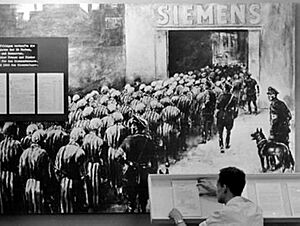List of subcamps of Ravensbrück facts for kids

Ravensbrück concentration camp was a large prison camp built by Nazi Germany during World War II. It was special because it was the main Nazi camp built specifically for women. By 1944, Ravensbrück had many smaller camps connected to it, called subcamps. These subcamps were spread out across a wide area, from Austria to the Baltic Sea.
Tens of thousands of women were held in these camps. They were forced to work for different companies and industries, often in very harsh conditions. The subcamps were like smaller branches of the main Ravensbrück camp, helping the Nazis use prisoners for forced labor.
What Were Subcamps?
Subcamps were smaller prison camps that were controlled by a larger, main concentration camp. For Ravensbrück, these subcamps were set up in different places to provide forced labor for factories and businesses. The prisoners, mostly women, were made to work long hours, often making weapons or other goods for the German war effort.
Where Were These Subcamps Located?
The subcamps of Ravensbrück were located in many different towns and cities. Here are some examples of places where these subcamps were found, and some of the companies that used the forced labor:
- Altdorf Lake and Barth: Prisoners here were forced to work for Heinkel-Flugzeugwerke, a company that made airplanes.
- Berlin: There were more than ten subcamps in and around Berlin.
- Grüneberg: This camp held over 1,000 prisoners who worked for Metall-Poltekonzern, a company that made ammunition.
- Karlshagen and Peenemünde: These areas were important for rocket development, and prisoners were forced to work on related projects.
- Malchow and Neubrandenburg: These were large subcamps, each holding thousands of prisoners.
- Rostock: Prisoners worked for Heinkel-Flugzeugwerke here as well.
- Stargard: Prisoners worked for Gerätewerk Pommern GmbH.
Many of these subcamps were later transferred to other main concentration camps, like Buchenwald, Sachsenhausen, or Flossenbürg, as the war continued.
Life in the Subcamps
Life in the subcamps was extremely difficult. Prisoners faced starvation, disease, and brutal treatment from the SS guards. They were forced to work in factories, mines, or on farms, often with very little food or rest. The purpose of these subcamps was to exploit the prisoners for their labor, supporting the Nazi war machine.
See also

